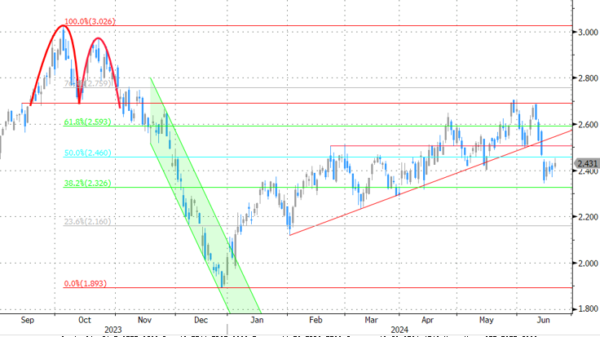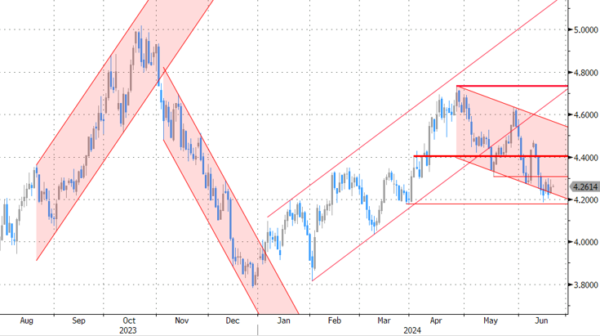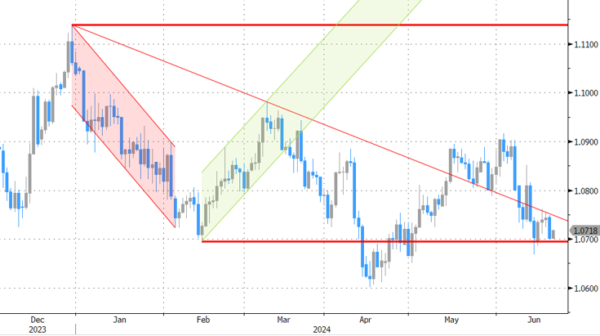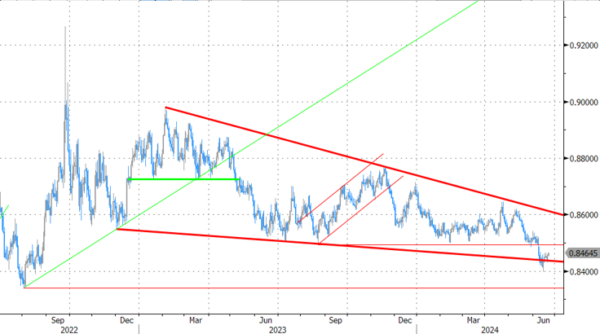Markets
US invertors returning after Wednesday’s Juneteenth holiday found some disappointing, admittedly mostly second tier, US data (jobless claims at a high 238k, housing starts and permits declining and the Philly Fed business outlook unexpectedly easing). US bond markets didn’t take notice. Yields even regained slightly ground rising between 2.5 bps (2-y) and 4.2 bps (30)y). German yields showed a similar pattern adding between 2.0 bps (2-y) and 3.9 bps (30-y). Spreads of France and peripheral intra-EMU bonds versus Bunds mostly narrowed slightly (about 2 bps). A new French election poll (Toluna Harris Interactive) still indicated the lead for the Rassemblement National (33%) followed by the Left Alliance (26%). President Macron’s group apparently drew some more support than in previous polls (21%). European equities (EuroStoxx50 +1.27%) outperformed the US (S&P 500 -0.25%). Still, the euro lost against the dollar with EUR/USD drifting to low 1.07 area (close 1.0702). The Bank of England left its policy rate unchanged in a 7-2 voting balance. Despite recent sticky core/services inflation, several members who currently still voted for an unchanged decision labelled their assessment ‘finely balanced’, suggesting they were moving closer to a rate cut. Gilts outperformed Bunds and Treasuries with the UK curve steeping (2-y -3 bps, 30-y +1.4 bps). Money markets again discount a 60% change of an August BoE 25 bps cut which is almost fully discounted for September. Sterling lost some modest ground, with EUR/GBP drifter further away from the 0.84 support area (close 0.8455).
Asian equities mostly showed modest losses as US (tech) stock yesterday failed to hold on to opening gains. US yields are little changed. The dollar eases marginally after yesterday’s rebound (EUR/USD 1.0715, DXY 105.54). Later today, the US and EMU PMI releases will provide an update on the EMU and US economies. For EMU a modest further improvement (composite index) is expected (52.5 from 52.2). However, both the survey outcome and the market reaction might be affected by the uncertainty on the outcome of the French elections. We see recent lows for the German 10-y yield (2.36%) and the 10-y EMU swap (2.70%/2.68% area) to provide decent support, even in case of a disappointing release. After recent softer US data, also keep an close eye at the US measure. After a strong rebound last month a setback to 53.5 from 54.5 is expected. A negative surprise might push money markets to fully discount a scenario of a double Fed rate cut in September and December. This morning, UK May retail sales (after a poor April reading) rebounded more than expected (2.9% M/M, 1.3% Y/Y). Sterling gains modest ground after the release (EUR/GBP 0.846). However, price data probably are more important to shape BoE governors’ assessment rather than volatile (retail sales) data. UK PMI’s are scheduled for release later today.
News & Views
Japanese inflation accelerated in May from April in most gauges, though slightly less so than expected. The headline figure picked up from 2.5% to 2.8%, breaking with a two-month decline. The series excluding fresh food (the Bank of Japan’s preferred measure) rose from 2.2% to 2.5%. Core CPI (ex. fresh food and energy) decelerated from 2.4% to 2.1%. Services inflation, with close ties to wage growth, eased from 1.7% to 1.6% though in what perhaps may disappoint the Bank of Japan seeking for a (domestic) consumption-driven sustainable return of inflation to 2%. However, the result of the spring wage negotiations (shunto) still have to filter through in Japanese consumer’s wages. These will come on top of the government’s income tax rebate and could support spending going forward. It makes the July meeting – with a new quarterly report – still a live one from a market point of view. There’s currently a 50% chance priced in for a 10 bps rate hike. The Japanese yen this morning trades stoic after closing at a new 34-y low yesterday around USD/JPY 158.9. Previous FX interventions level just north of 160 are coming dangerously close …
… which brings us to yesterday’s decision of the US Treasury department to add Japan to its “monitoring list” for foreign-exchange practices. It didn’t label the country as a currency manipulator though. Japan was put on the list not so much because of the FX interventions (which fell outside the scope of the report due to timing) but because of the large bilateral trade and current account surpluses Japan has with the US. The report on the matter said that such operations should be reserved for very exceptional circumstances only and that Japan has been transparent about it. The other countries to stay on the list included China, Germany, Malaysia, Singapore, Taiwan and Vietnam.
Graphs
GE 10y yield
The ECB cut its key policy rates by 25 bps at the June policy meeting. A more bumpy inflation path in H2 2024, the EMU economy gradually regaining traction and the Fed’s higher for longer US strategy make follow-up moves difficult. Markets are coming to terms with that. For the time being, though, the political narrative dominates. After hitting a new YtD top at 2.7%, the German 10-yr yield corrected lower on safe haven bids.
US 10y yield
The Fed is seeking more evidence than just one slower-than-expected (May) CPI is providing. Upgraded inflation forecasts and a higher neutral rate complicate the exact timing of a first cut further. June dots suggest one move in 2024 followed by four more next year. Markets are positioned more aggressively, turning the recent low in yields into a technical support zone. The US 10-y yield is testing the downside of the 4.2/4.7% trading range.
EUR/USD
EUR/USD is trapped in the 1.06-1.09 range. The desynchronized rate cut cycle with the ECB exceptionally taking the lead, strong US May payrolls and a swing to the right in European elections pulled the pair away from 1.09 resistance. The Fed meeting balanced the weaker than expected US CPI outcome. Euro fragility makes a return to the 1.06 downside more likely than not.
EUR/GBP
Debate at the BOE is focused at the timing of rate cuts. May headline inflation returned to 2%, but core measures weren’t in line with inflation sustainably returning to target any time soon. Still some BoE members at the June meeting appeared moving closer to a rate cut. This might cap further sterling gains. At the same time, the euro remains vulnerable to political event risk going into the France elections. EUR/GBP 0.8400 recently showed a solid support.

















